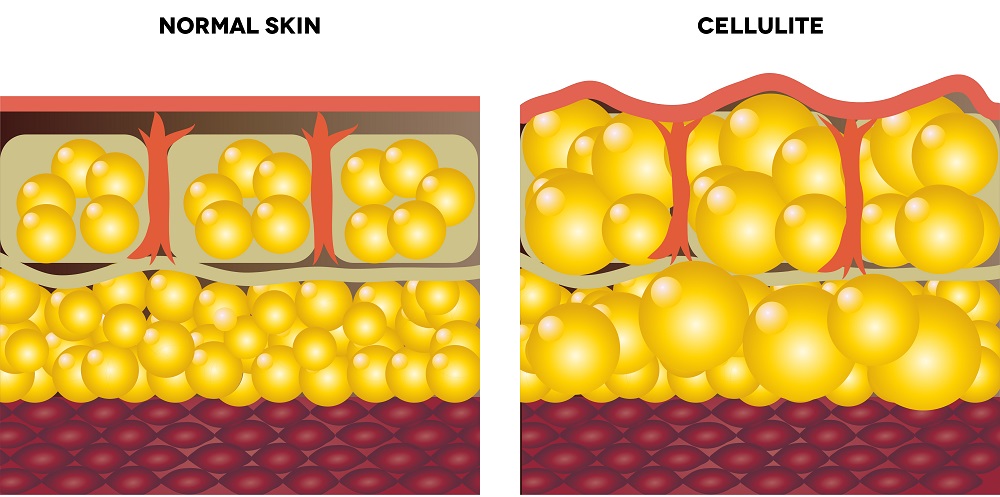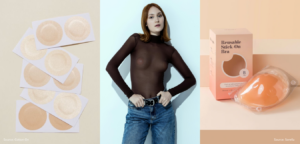Body
Cellulite Treatments, Myths and Facts — from Dermatologists!
Aaah, cellulite: so common, but so misunderstood. Nine out of 10 women will get cellulite somewhere on their bodies —...
By: Dedet Panabi / December 3, 2019

Aaah, cellulite: so common, but so misunderstood. Nine out of 10 women will get cellulite somewhere on their bodies — even celebrities.
Demi Lovato recently shared an unedited bikini pic. She had cellulite, and apologized for all the other bikini pics that were Photoshopped so she could meet an impossible standard of a perfect body. “This is what I got. I want this new chapter in my life to be about being authentic to who I am rather than trying to meet someone else’s standards.”
So cellulite is real, and it happens to all of us. But we can understand why it happens, how we can make it look better, and what cellulite treatments are worth our time and money.
Contents
What is cellulite?
Let’s dispel one of the most common myths about cellulite right now. Cellulite is not caused by excess fat. You don’t get it just because you gained weight, and you can’t lose it by exercising. Very skinny people can get cellulite. In a cruel twist of irony, your cellulite may even become more obvious after you lose weight.

Cellulite is fat cells that push against the pushing up against our skin’s connective tissue. Think of your skin as a net, with fat cells behind it. If the net becomes loose, the fat cells can poke through.
So, putting aside all the skin jargon, the problem isn’t the fat cells but the connective tissue. When your skin stretches and loses elasticity, your cellulite becomes more obvious.
What causes cellulite?
It runs in your family
“Cellulite is a genetic thing,” Dr. Robyn Gmyrek, who established Columbia University’s Cosmetic Skin and Laser Center. If you’re predisposed to it, you can start seeing it in your twenties.
You’re a woman
Plastic surgeon Matthew Schulman says cellulite is more common in women, because of our collagen structure. Women’s collagen are arranged in parallel rows, while men’s collagen have an X pattern. “This creates only very small fat compartments and doesn’t allow for dimpling of the skin,” Dr. Schulman explains.

Your lympathic system is sluggish
Dr. Jeannette Graf, assistant clinical professor of dermatology at New York’s Mount Sinai Medical Center says cellulite can be worsened by bloated lymph nodes.
Your lymphatic system is like your body’s sewer system, which flushes out toxins and other waste. However, if you have unhealthy habits — like unhealthy diet or zero exercise — your lymph nodes get clogged.
That’s why many cellulite treatments will involve stimulating circulation and body detoxes. Your skin will look better, but that doesn’t mean your cellulite’s disappeared. “Essentially, you relieve the bloating and fluid retention that makes cellulite more obvious,” says Dr. Graf.
Your skin is sagging
Ageing doesn’t cause cellulite, but mature skin tends to have less collagen and elastin. As skin gets more saggy, cellulite becomes more noticeable.
However, other conditions can make your skin stretch and sag, like dramatic weight loss or giving birth. Any time your body shape and size changes, you’re at a higher risk for stretch marks and cellulite.
What cellulite treatments can cure cellulite?
Sorry to disappoint you, but there are no cures. “There’s no permanent fix, no matter how invasive, or expensive, a procedure is,” says Dr. Robyn Gmyrek.
Cellulite treatments can shrink existing, individual dimples or temporarily firm up the skin. However, your body will produce more cellulite. “In a way, cellulite is like diabetes: you can manage it, but you can’t cure it. That doesn’t mean you give up and never try to make your skin look better, but don’t fall for the hype of a miracle cellulite cream or procedure that says it will make cellulite disappear forever,” says Dr. Andrew Simmons.
Can exercise make cellulite go away?
So, are those “best exercises for cellulite” articles even true? Uhm yes and no. Exercise can help tone your muscles and burn some of the fat, but there will still be cellulite. It’s just not obvious — and in some cases, may still remain obvious, even if you’re super fit.
That’s not to say that exercise is useless. “Regular physical activity helps control hormones like adrenalin and noradrenaline, which has been linked with cellulite,” sats Dr. Gmyrek. In that way, it can prevent cellulite — or at least, keep it from getting really bad.
Some exercises are also more effective at reducing the appearance of cellulite. You need high-intensity exercises that burn fat, and strength exercises that build muscle. Foam-rolling exercises can also stimulate circulation in the area.

Can losing weight reduce cellulite?
Weight loss can help at the beginning, since water retention and higher fat ratios can make cellulite more visible. “However, even when you slim down, the tissue is still stretched and damaged,” says Sue Hitzman, celebrity trainer and creator of the MELT method.
That’s why you need to pair dieting with firming exercising and cellulite treatments that help repair tissue. “Cellulite is never just about weight, but skin. And your skin health depends on many things: genetics, skincare or bodycare routines, nutrition, lifestyle, sun exposure,” says Dr. Joshua Zeichner, M.D., director of cosmetic and clinical research in dermatology at Mt. Sinai Hospital.
What should I look for in a cellulite cream or lotion?
“Cellulite is a complex architectural disruption that is largely happening deep in the skin and you won’t be able to penetrate that area with topical products,” says Evan Rieder, a dermatologist at NYU Langone Health.
However, if you apply a cream everyday, you can get a temporary skin boost — and any little bit helps! Just remember that your skin will go back to its original appearance once you stop using it.
So what should you look for in a cellulite cream or lotion? Dr. Francesca Fusco — celebrity dermatologist and assistant clinical professor of dermatology at Mount Sinai School of Medicine — recommends looking for ingredients like caffeine and retinol.
Caffeine boosts blood flow and temporarily shrinks fat cells, while retinol repairs skin cells. If you are layering two products, apply retinol before caffeine.
Other skin experts recommend cellulite creams with Vitamin C and peptides (which help with collagen synthesis). Moisturizing and hydrating ingredients like shea butter and glycerin also plump up the skin, and make it look smoother.
What cellulite treatments work?
“In-office treatments with radio frequency devices or needles to break up fibrous bands can be effective for a few years,” says Dr. Reider. The FDA has approved some treatments for cellulite.
Cellfina
So far, Cellfina has gotten the most buzz. It’s the only minimally invasive procedure that’s clinically proven to reduce cellulite for 3 years — the longest among any cellulite treatments. It uses needles to break up the bands. Painful, pricey, but at least you don’t have to worry about cellulite for a long time.
VelaShape
Velashape cellulite treatments use a combination of radiofrequency, infrared light and suction massages to break down fat chambers and make the area look less puffy. It has minimal discomfort, but you may need several sessions to see results.
Cellulaze
Cellulaze cellulite treatments use lasers, which can stimulate collagen production and make the skin look thicker, and break down the fat and fat bands. Aside from smoothing out your orange-skin texture, it can make the area look more toned.
BTL Unison
This non-surgical cellulite treatment uses radio frequency and acoustic waves, and claims to use the only machine that fights all 5 main causes of cellulite. You can start seeing a difference in 4 weeks, and results last for about 18 months. Watch the video demo:

Read about other cellulite treatments in Singapore that can help make your skin look firmer, smoother and more toned. You can also check out our directory of Singapore clinics to help you find the best doctors and non-invasive body treatments in Singapore.












